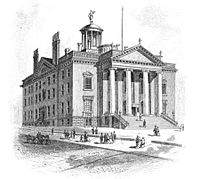|
62nd New York State Legislature
The 62nd New York State Legislature, consisting of the New York State Senate and the New York State Assembly, met from January 1 to May 7, 1839, during the first year of William H. Seward's governorship, in Albany. BackgroundUnder the provisions of the New York Constitution of 1821, 32 Senators were elected on general tickets in eight senatorial districts for four-year terms. They were divided into four classes, and every year eight Senate seats came up for election. Assemblymen were elected countywide on general tickets to a one-year term, the whole Assembly being renewed annually. In 1838, Fulton County was split from Montgomery County. Fulton and Hamilton counties were joined in one Assembly district and apportioned 1 seat, the remaining 2 seats of the previous Hamilton-Montgomery district were apportioned to the now smaller Montgomery County. At this time there were two political parties: the Democratic Party and the Whig Party. On September 12, 1838, the Whig state convention met at Utica, and nominated William H. Seward for Governor, and Speaker Luther Bradish for Lieutenant Governor. On the same day, the Democratic state convention met at Herkimer, and nominated Gov. William L. Marcy and Lt. Gov. John Tracy unanimously for re-election. On October 3, 1838, a state convention of former Democrats met under the name of "Conservatives" (among them U.S. Senator Nathaniel P. Tallmadge) at Syracuse, and endorsed the Whig nominees Seward and Bradish. ElectionsThe State election was held from November 5 to 7, 1838. William H. Seward and Luther Bradish were elected Governor and Lieutenant Governor. State Senator Chester Loomis (7th D.) was defeated for re-election.
SessionsThe Legislature met for the regular session at the Old State Capitol in Albany on January 1, 1839; and the Assembly adjourned on May 6, the Senate on May 7. On January 1, George W. Patterson (W) was elected Speaker. In the Senate, the mode of appointing the standing committees was changed. The committees had usually been appointed by the lieutenant governor (who is ex officio President of the Senate). At this session, the lieutenant governor was a member of the minority party, and the Democratic majority voted to appoint the committees by ballot. On January 26, Canal Commissioner Stephen Van Rensselaer died. On February 4, the Legislature elected John C. Spencer (W) to succeed John A. Dix (D) as Secretary of State; Bates Cooke (W) to succeed Azariah C. Flagg (D) as State Comptroller; Willis Hall (W) to succeed Samuel Beardsley (D) as Attorney General; and Jacob Haight (W) to succeed Gamaliel H. Barstow (W) as State Treasurer. On February 5, the Legislature failed to elect a U.S. Senator to succeed Nathaniel P. Tallmadge, and the seat became vacant on March 4, 1839. On February 18, the Legislature elected Samuel B. Ruggles (W) a Canal Commissioner, to fill the vacancy caused by the death of Van Rensselaer. State SenateDistricts
Note: There are now 62 counties in the State of New York. The counties which are not mentioned in this list had not yet been established, or sufficiently organized, the area being included in one or more of the abovementioned counties.
MembersThe asterisk (*) denotes members of the previous Legislature who continued in office as members of this Legislature.
Employees
State AssemblyDistricts
Note: There are now 62 counties in the State of New York. The counties which are not mentioned in this list had not yet been established, or sufficiently organized, the area being included in one or more of the abovementioned counties.
AssemblymenThe asterisk (*) denotes members of the previous Legislature who continued as members of this Legislature. Employees
Notes
Sources
|
||||||||||||||||||||||||||||||||||||||||||||||||||||||||||||||||||||||||||||||||||||||||||||||||||||||||||||||||||||||||||||||||||||||||||||||||||||||||||||||||||||||||||||||||||||||||||||||||||||||||||||||||||||||||||||||||||
